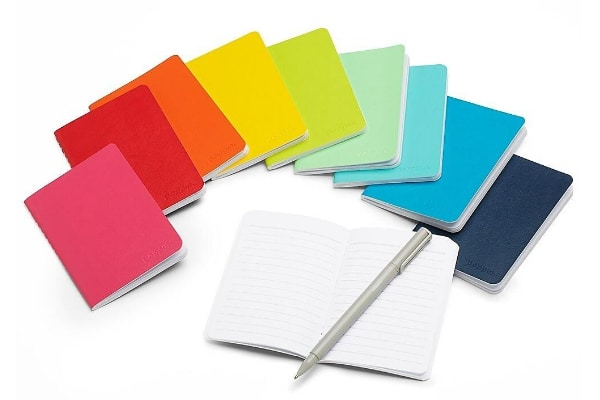
In this digital age, we’re online almost all the time. We stare at screens and type on keyboards. There is always a new app or widget that promotes itself as “the best way to be organized and productive.” But for people like me who are “doodlers,” we feel a little lost if we don’t write things down. I always have a notebook ready to scribble down notes. Here are a few reasons why you might want to try paper planners.
Memory Retention
There have been several studies that link improved memory retention to handwriting. Three studies found that students who took lecture notes by hand scored higher in tests than students who took notes on computers. Computer users tend to transcribe verbatim, but those who write process the information and reframe it in their own words. Writing seems to improve comprehension and memory, whereas typing is just mindless processing.
Handwriting
Researchers found that handwriting is important for brain development and reading ability in children. Generally speaking, children who print/write build stronger reading skills much faster than children who type. I don’t know if there have been any studies on adults that correlate a decline in reading ability due to lack of handwriting, but I’m not going to take a chance. I’ll keep handwriting my notes and thoughts!
Creativity
Many years ago, one experiment showed that using colour can enhance people’s ability to extract information from graphs and charts and improve their decision-making ability. However, too many different colours interfered with their data analysis.
With paper planners, you can use colours – stickers, designs, and doodles – to help you remember. Therefore, taking the time to personalize your planner will help you retain the information. Of course, if you make it enjoyable to use, you will use it more, and that will improve your productivity. But be careful you don’t spend more time turning it into an art project than using it as a planner.
Distractions
How many times have you opened your smartphone to add a reminder, then realized you had emails, and two hours later, you forgot what it was you wanted to add to your reminders list? Paper planners do not have distractions like smartphones! It’s easy; open the book, write something down, close the book. You can maintain your workflow. Another key point I’ve noticed, when you’re in a meeting, it is much less distracting for someone to jot down a reminder on paper than it is for them to put it on their smartphone. (Or maybe I’m just old-fashioned?)
Choosing A Planner
First, decide how and when you will be using your planner. If you are carrying it in your pocket or purse, these small colourful books are ideal. For the outdoorsy type, Rite in the Rain all-weather memo books might be the paper planners for you. If you want a larger notebook, Staples has over a thousand to choose from, and stationery stores have even more options. Other options to think about are:
- Pages with lines or a grid
- Fixed pages or ones easy to remove and refill
- A binder-type book where you can add different styles of pages
- Pockets in the covers
- Built-in dividers to create separate sections
My favourite paper planner is the Blueline Notepro which lies flat and has a flexible and durable cover. Because it lies flat, it is a good choice for left-handed people, as is the Moo Hardcover Notebook. The ARC Notebook System from Staples is another popular choice for those who want to customize their planner.
Getting Creative
Use your favourite pens or pencils to write in your planner. A 4-colour ballpoint pen is a cheap and cheerful way to add colour while only carrying one writing tool. While much more expensive, the Space Pen will write at any angle on almost any surface (zero gravity, underwater, etc.).
For more creativity, colour-coded, removable labels are a fast and easy way to highlight events in your planner. You can use decorative calendar stickers to make it more personalized. There is no limit, and that’s the joy of a paper planner.
Do you need time management advice? Contact the Out of Chaos team to book a personal productivity session or a workplace workshop.
Image courtesy Staples Canada.
References
- Christ, Richard E. “Review and Analysis of Color Coding Research for Visual Displays.” Human Factors: The Journal of the Human Factors and Ergonomics Society, vol. 17, no. 6, Dec. 1975, pp. 542–570., https://doi.org/10.1177/001872087501700602.
- Engelhardt, Laura. “The Effects of Handwriting Experience on Functional Brain Development in Pre-Literate Children.” Trends in Neuroscience and Education, vol. 1, no. 1, Dec. 2012, pp. 32–42., https://doi.org/10.1016/j.tine.2012.08.001.
- Herbert, Wray. “Ink on Paper: Some Notes on Note Taking*.” Association for Psychological Science – APS, Association for Psychological Science, 28 Jan. 2014, psychologicalscience.org/news/were-only-human/ink-on-paper-some-notes-on-note-taking.html.
- Hoadley, E. “Investigating the Effects of Color.” Communications of the ACM, vol. 33, no. 2, Feb. 1990, pp. 120–125., https://doi.org/10.1145/75577.75578.
- Mueller, Pam A., and Daniel M. Oppenheimer. “The Pen Is Mightier Than the Keyboard.” Psychological Science, vol. 25, no. 6, 23 Apr. 2014, pp. 1159–1168., https://doi.org/10.1177/0956797614524581.
